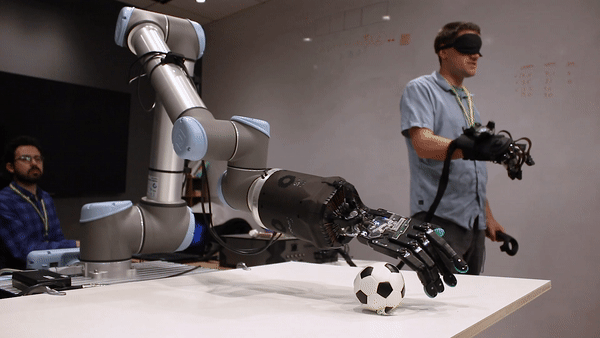Telerobotics in the Cath Lab: From PCI to Neurointervention
A telerobotics demonstration in the UK. With vast improvements in smart fabrics, dexterity, haptic feedback, and communication speeds, an operator can manipulate its robot’s arms and hands with precision from anywhere.
Image credit: Shadow Robot Company
Distance operations reduce radiation and expand access—if you package them as a service
Precision robotics is rewriting interventional cardiology and neurovascular care by adding something human hands can’t: distance. Robotic platforms let operators work from shielded consoles that are metres—or kilometres—away, cutting radiation dose while keeping robot-level precision at the lesion. The result isn’t just safety; it’s the possibility of expertise travelling to patients rather than the other way round.
In 2018, a team in Ahmedabad, India, performed the first in-human telerobotic percutaneous coronary intervention (PCI), treating five patients while the interventional cardiologist operated from ~32 km away on a Corindus (now Siemens Healthineers) platform. That result, published as a clinical report, showed feasibility for remote percutaneous coronary intervention under real-world network conditions—a turning point that moved “tele-PCI” from demo to dataset.
Even inside the cath lab, robotic-assisted PCI has measurable benefits. Reviews and registry studies report reduced physician radiation exposure and potential improvements in wire/catheter stability for complex lesions, with platforms iterating from the early CorPath 200—the first FDA-cleared robotic PCI system that lets the operator manipulate the guidewire and balloon/stent from a shielded cockpit—to CorPath GRX, the next-generation system that adds active guide-catheter control and finer joystick precision while preserving remote operation. While not every case warrants robotics, the pattern is consistent: when procedures run long or complexity rises, robotic precision plus shielding makes a compelling occupational-health and quality case.
The neuro side is following fast. In 2019, clinicians reported the first robotic-assisted neuroendovascular intervention, using robotic control to navigate cerebrovascular anatomy. Subsequent studies and reviews have explored indications from aneurysm coiling to thrombectomy, where millimetre-level control and tremor filtration are prized. Telerobotics in neuro raises thornier latency and consent issues, but the clinical pull is strong where time to expertise is the difference between full recovery and disability.
How do you make this investable? Sell assurances, precision, reliability, and reach rather than concepts. Hospitals care about three things: (1) sharply reduced operator dose across the service line; (2) precision that widens the window of treatable cases; and (3) a path to hub-and-spoke coverage, where experts in regional centres can assist or perform procedures remotely for smaller hospitals. That suggests packaging telerobotics as an availability service—certified consoles, secure low-latency links, training and proctoring, and SLAs on support and cybersecurity—rather than as capital alone.
Evidence moves decision-makers. The offer must be anchored in peer-reviewed cases (remote PCI; robotic neurointervention), learning curves published for teams adopting robotic workflows, and radiation-dose data made transparent before and after adoption. For health systems, quantifying how remote assistance could reduce patient transfers or extend coverage to underserved regions without building new cath labs are equally essential.
Risk and governance are integral. Remote procedures need network redundancy, encryption and audit trails, plus clear policies for failover to bedside teams. Credentialling and consent must reflect the reality that the lead operator may be kilometres away. Vendors who show regulators and insurers a serious safety case—from human-in-the-loop controls to cybersecurity drills—will shorten time to approval and reimbursement.
The horizon is not hands-free cath labs; it’s supervised reach—operators protected from radiation, able to extend their skills beyond hospital walls. If that’s packaged properly and the buyer isn’t gambling on sci-fi, telerobotics becomes a safer, broader care package that can be acquired right now.
